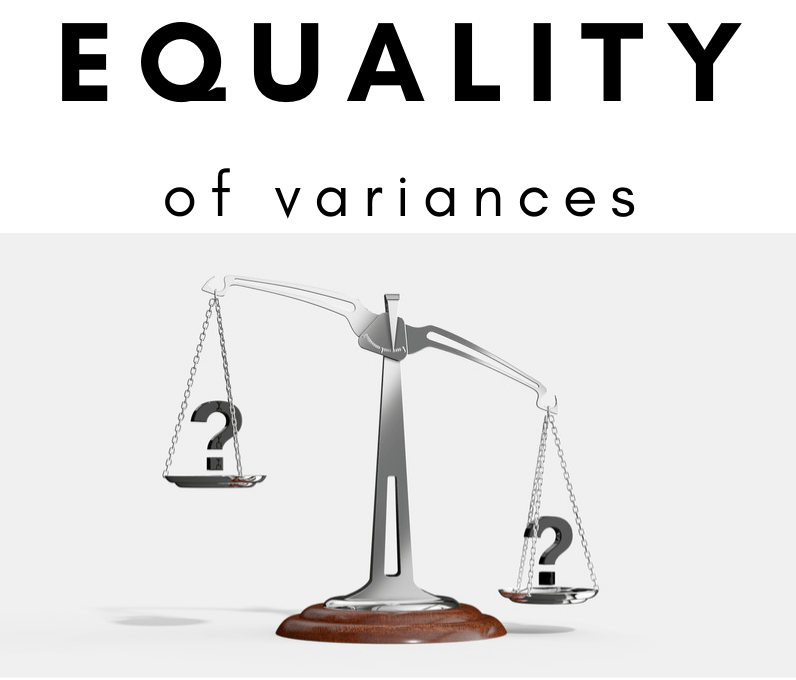Equality of Variances in R-Homogeneity test-Quick Guide
Equality of Variances in R, in this article, we are describing variance comparison of 2 or more samples.
There are different types of tests that can be utilized to assess the equality of variances.
1) F-test:- Used for two groups variance comparison. Data must be normally distributed.
2) Bartlett’s test:- Used for two or more groups variance comparison. Data must be normally distributed.
3) Levene’s test:- An alternative to Bartlett’s test for non-normally distributed data.
4) Fligner-Killeen’s test:- A non-parametric test for non-normal data.

Two sample equality of variances in R
In most of the parametric methods, one of the assumptions is equality of the variances or some situation we want to measure the variability of the new instruments compared to old ones. Such kind of case F test will be very useful.
Repeated Measures of ANOVA in R Complete Tutorial »
1. F-test in R
The F test statistic can be obtained by calculating the ratio of the two variances.
F=VAR(A)/VAR(B)
In the F test, the ratio deviates more from 1 then stronger the evidence of unequal variances.
Before doing the F test, we need to check one of the major assumptions is data should be normally distributed.
Normality distribution can be assessed based on the Shapiro test or visually using a QQ plot.
One of our old posts we detailed mentioned about normality testing please check it here.
If any violation observed from normality then it better is to use Levene’s test or Fligner-Killeen test.
Levene’s test or Fligner-Killeen test is less sensitive and appropriate for when data is distributed non-normally.
Let’s see the F test syntax,
var.test(values ~ groups, data, alternative = "two.sided")
or
var.test(x, y, alternative = "two.sided")
ToothGrowth data set we used for F test calculation.
Let’s see the data structure,
str(ToothGrowth) 'data.frame': 60 obs. of 3 variables: $ len : num 4.2 11.5 7.3 5.8 6.4 10 11.2 11.2 5.2 7 ... $ supp: Factor w/ 2 levels "OJ","VC": 2 2 2 2 2 2 2 2 2 2 ... $ dose: num 0.5 0.5 0.5 0.5 0.5 0.5 0.5 0.5 0.5 0.5 ...
Total 60 observations and 3 variables and the variable supp contains two groups. Let’s check the variance for the same.
Before that calculate the Shapiro test for the normality assumption validation,
Naive Bayes Classification in R » Prediction Model »
Shapiro Test:-
shapiro.test(ToothGrowth$len)
Shapiro-Wilk normality test
data: ToothGrowth$len W = 0.96743, p-value = 0.1091
The p value is greater than 0.05, we can assume the normality.
res.ftest <- var.test(len ~ supp, data = ToothGrowth) res.ftest
F test to compare two variances
data: len by supp F = 0.6386, num df = 29, denom df = 29, p-value = 0.2331 alternative hypothesis: true ratio of variances is not equal to 1 95 percent confidence interval: 0.3039488 1.3416857 sample estimates: ratio of variances 0.6385951
The p-value of 0.2331 is greater than the significance level of 0.05. We can conclude that there is no significant difference between the two variances.
Compare more than two sample variances in R
When comparing more than two samples Bartlett’s test, Levene’s test, or Fligner-Killeen’s test will be more appropriate.
Coming to statistical hypotheses, Bartlett’s test, Levene’s test, or Fligner-Killeen’s test,
Ho: All populations variances are equal
H1: At least two of them different
When using Bartlett’s test one of the main assumptions data should be normally distributed. In the case of nonnormal data, the Levene test is an alternative to the Bartlett test.
If data is non-normally distributed, the Fligner-Killeen test is a non-parametric test alternative.
LSTM Network in R » Recurrent Neural network »
2. Bartlett’s test in R
Syntax of Bartlett’s test is
bartlett.test(formula, data)
Let’s check the equality of variance, We are using PlantGrowth dataset contains 30 observations and 2 variables.
str(PlantGrowth) 'data.frame': 30 obs. of 2 variables: $ weight: num 4.17 5.58 5.18 6.11 4.5 4.61 5.17 4.53 5.33 5.14 ... $ group : Factor w/ 3 levels "ctrl","trt1",..: 1 1 1 1 1 1 1 1 1 1 ...
The column group contains 3 factor variables ctrl, trt1, and trt2. Before doing Bartlett’s test let’s check the normality assumption.
Shapiro Test:-
shapiro.test(PlantGrowth$weight)
Shapiro-Wilk normality test
data: PlantGrowth$weight W = 0.98268, p-value = 0.8915
We can assume that data is normally distributed.
res <- bartlett.test(weight ~ group, data = PlantGrowth) res
Bartlett test of homogeneity of variances
data: weight by group Bartlett's K-squared = 2.8786, df = 2, p-value = 0.2371
The p-value is 0.2371 is greater than the significance level of 0.05. We can conclude that there is no significant difference between the tested sample variances.
How to clean the datasets in R? » janitor Data Cleansing »
3. Levene’s test in R
Levene test function is from car package, let’s load the library.
library(car) leveneTest(weight ~ group, data = PlantGrowth)
Levene’s Test for Homogeneity of Variance (center = median)
Df F value Pr(>F) group 2 1.1192 0.3412 27
The p-value is 0.3412 is greater than the significance level of 0.05. We can conclude that there is no significant difference between the tested sample variances.
Levene’s test with multiple independent variables can check based on ToothGrowth dataset,
ToothGrowth dataset dose column stored as numeric variable let’s convert into factor variable first,
ToothGrowth$dose <- as.factor(ToothGrowth$dose) leveneTest(len ~ supp*dose, data = ToothGrowth)
Levene’s Test for Homogeneity of Variance (center = median)
Rank Order analysis in R » Optimal order & Probability
Df F value Pr(>F) group 5 1.7086 0.1484 54
4. Fligner-Killeen test in R
Will make use of the same data set,
fligner.test(weight ~ group, data = PlantGrowth)
Fligner-Killeen test of homogeneity of variances
data: weight by group Fligner-Killeen:med chi-squared = 2.3499, df = 2, p-value = 0.3088
The p-value is 0.3088 is greater than the significance level of 0.05. We can conclude that there is no significant difference was observed between the tested sample variances.
Summary
This article provides one-of-a-kind exams for assessing the equality of variances in R among groups.
Discriminant Analysis in r » Discriminant analysis in r »
Subscribe to the Newsletter and COMMENT below!
[newsletter_form type=”minimal”]



